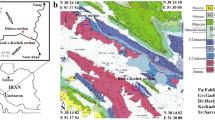Abstract
A section of pelagic limestones and marls of the Pabdeh Formation, containing vertebrate remains was investigated for calcareous nannoplankton and planktic foraminifera. It is located in the Zagros Mountains near the town Baba Heydar, Iran. The microfossils of the marls are indicative for an eutrophication in the photic zone of the sea with the bloom of r-strategists of calcareous nannoplankton. Planktic foraminifera are abundant and compare with assemblages of Tanzania and the Caucasus. The benthic foraminifera are of Midway type assemblages at a deposition depth of upper bathyal. Biostratigraphically the sequence belongs to nannoplankton zone NP 24 or planktic foraminifera zone P 20, upper Rupelian.
Kurzfassung
Im Zagros Gebirge, nahe der Stadt Baba Heydar, im Iran wurde eine Abfolge mariner, pelagischer Kalke und Mergel biostratigraphisch untersucht. Die Schichtfolge gehört zur Pabdeh Formation und ist durch eine Fossilführung mit Fischen, Vögeln und Pflanzenresten interessant. Die untersuchten Proben unterhalb und oberhalb dieser Fossilreste zeigen ähnliche Mikrofossilvergesellschaftungen. Blooms von wenigen Arten kalkigen Nannoplanktons weisen auf eine Eutrophierung der obersten Wasserschichten hin. Die reiche Vergesellschaftung planktonischer Foraminiferen zeigt Beziehungen zum Unteroligozän von Tanzania und des Kaukasus. Die verhältnismäßig reiche benthische Foraminiferenfauna im tieferen Teil der Schichtfolge entspricht einer Ablagerungstiefe im oberen Bathyal. Biostratigraphisch gehört die Abfolge in das mittlere Oligozän (oberer Rüpel), Nannoplanktonzone NP 24, Zone der planktischen Foraminiferen P 20.
Similar content being viewed by others
References
Berggren, W. A., Kent, D. V., Swisher, C. C., III &Aubry, M.-P. (1995): A revised Cenozoic geochronology and chronostratigraphy. — SEPM (Society for Sedimentary Geology), Spec. Publ.,54: 129–212, 25 text-figs; Tulsa/Okla.
Blaicher, J. (1970): „Globigerinae“ of the Sub-Menilite Globigerina Marls. — Biul. Inst. geol.,221: 137–175, 10 text-figs, 21 pls; Warszawa.
Blow, W. H. (1969): Late middle Eocene to Recent planktonic foraminiferal biostratigraphy. — Proc. First Internat. Conf. Planktonic Microfossils, Geneva 1967,1: 199–422, 43 text-figs, 54 pls; Leiden (E. J. Brill).
Blow, W. H. (1979): The Cainozoic Globigerinida. —1–3: 1413 p., 264 pls; Leiden (E. J. Brill).
Blow, W. H. &Banner, F. T. (1962): The Mid-Tertiary (Upper Eocene to Aquitanian) Globigerinaceae. — In:F. E. Eames, F. T. Banner, W. H. Blow &W. J. Clarke, Fundamentals of Mid-Tertiary stratigraphical correlation: 61–151, pls 8–17; Cambridge/UK (Cambridge Univ. Press).
Bolli, H. M. &Saunders, J. B. (1985): Oligocene to Holocene low latitude planktic foraminifera. — In:H. M. Bolli, J. B. Saunders &K. Perch-Nielsen, Plankton stratigraphy: 155–262, 46 text figs; Cambridge, New York (Cambridge Univ. Press).
Bubik, M. (1992): Low diversity calcareous nannoplankton assemblages from Oligocene Sitborice member of the Menilitic Formation (West Carpathians, Czechoslovakia) from Bystrice nad Olsi. — In: B.Hamrsmid & J.Young [Eds], Nannoplankton Research, vol. II, Tertiary biostratigraphy and paleoecology; Quaternary coccoliths. — Knihovnicka Zemni Plyn Nafta,14b: 223–245; Hodonín.
Charollais, J., Hochuli, P. A., Oertli, H. J., Perch-Nielsen, K., Toumarkine, M., Rögl, F. &Pairis, J.-P. (1980): Les marnes à foraminifères et les Schistes à Meletta des chaînes subalpines septentrionales (Haute-Savoie, France). — Eel. geol. Helv.,73 (1): 9–69, 19 text-figs, 8 pls; Basel.
Krasheninnikov, V. (1974): Some species of planktonic foraminifera from the Eocene and Oligocene deposits of South Armenia. — Voprosy Mikropaleont.,17: 95–135, 10 pls; Moskva.
Krhovsky, J. (1983): Foraminiferida of the Eocene/Oligocene boundary from the Pouzdrany Formation (the West Carpathians. Czechoslovakia). — Miscellanea Micropalaeontologica. — Knihovnicka Zemní Plyn Nafta,4: 71–98, 10 pls; Hodonín.
Krhovsky, J., Adamova, J., Hladikova, J. &Maslowska, H. (1992): Paleoenvironmental changes across the Eocene/Oligocene boundary in the Zdanice and Pouzdrany units (Western Carpathians, Czechoslovakia): the long-term trend and orbitally forced changes in calcareous nannofossil assemblages. — In: B.Hamrsmid & J.Young [Eds], Nannoplankton Research, vol. II, Tertiary biostratigraphy and paleoecology; Quaternary coccoliths. — Knihovnicka Zemní Plyn Nafta,14b: 105–187, 10 text-figs, 22 pls; Hodonín.
Krhovsky, J. &Djurasinovic, M. (1992): The nannofossil chalk layers in the early Oligocene Sitborice member in Velke Nemcice (the Menilitic Formation, Zdanice Unit, South Moravia): orbitally forced changes in paleoproductivity. — In: B.Hamrsmid [Ed.], Nove vysledky v tercieru Zapadnich Karpat. — Knihovnicka Zemní Plyn Nafta,15: 33–53, 2 text-figs, 2 pls; Hodonín.
Martinotti, G. M. (1994):Subbotina angiporoides extinction, a Mid-Oligocene bioevent. — Report GSI/23/94: 17 p., 1 text-fig., 1 pl.; Jerusalem (Geol. Surv. Israel).
Author information
Authors and Affiliations
Additional information
Annotations toPeters &Hamedani,Frigidafons bahaheydriensis
Senckenbergiana lethaea, 80 (1): 29–37.
Rights and permissions
About this article
Cite this article
Hamrsmid, B., Rögl, F. Biostratigraphy of the Baba Heydar section, Iran. Senckenbergiana lethaea 80, 39–44 (2000). https://doi.org/10.1007/BF03043662
Received:
Accepted:
Issue Date:
DOI: https://doi.org/10.1007/BF03043662




